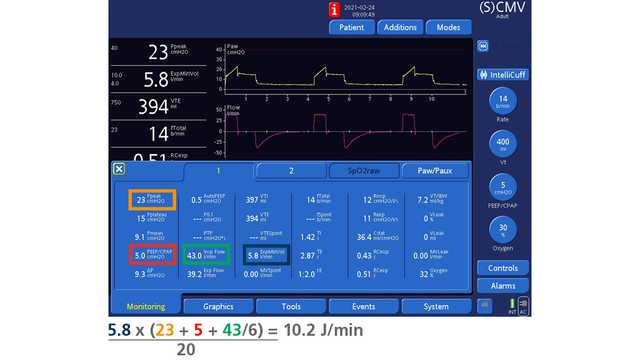
Author: Justin Seemueller, Respiratory Clinical Specialist, Sentara Norfolk General Hospital
Date of first publication: 24.02.2021

Takeaway messages
- Cumulative damage caused to the lung during mechanical ventilation can be expressed through mechanical power (total energy delivered in Joules per minute).
- High mechanical power has been associated with increased mortality, even where sample groups received low tidal volumes or low driving pressures.
- Simplified methods have been suggested for estimating mechanical power at the bedside.
- Further automation of these calculations through electronic medical record systems may allow for earlier interventions with the aim of improving outcomes.
A combination of several variables
It is a generally accepted practice to limit tidal volume (per IBW), plateau pressure, and driving pressure (Plat‑PEEP) within acceptable ranges for lung‑protective ventilation (
A simplified method for estimating mechanical power
Gattinoni et al. have utilized derivative formulas to estimate mechanical power as a metric to mitigate lung damage. The most accurate bedside method is complicated and requires clinicians to perform an inspiratory hold to measure plateau pressure for accurate resistance and elastance values (
Simplified methods have recently emerged to quickly estimate mechanical power without the need for an inspiratory hold maneuver. Gattinoni et al. proposed an acceptably accurate method for Volume Control ventilation; the simplified method was validated by comparing animal experimentation with a cohort of ICU patients from seven previously published studies (
Mechanical power and EMR systems
These new methodologies are interesting in the context of modern electronic medical record (EMR) systems, some of which can apply formulas to device integrated ventilator data. Epic is a fairly ubiquitous EMR system, and the company's system analysts have confirmed that it is possible to automatically calculate these types of shortened mechanical power formulas within new flowsheet rows. This presents an exciting prospect for generating instantaneous reports on all ventilator patients within a hospital system, who are currently receiving what might be considered unsafe levels of mechanical power. In two separate observational cohorts, a value of 17 J/min or greater was associated with a higher risk of death (
Footnotes
References
- 1. Giosa L, Busana M, Pasticci I, et al. Mechanical power at a glance: a simple surrogate for volume‑controlled ventilation. Intensive Care Med Exp. 2019;7(1):61. Published 2019 Nov 27. doi:10.1186/s40635‑019‑0276‑8
- 2. Amato MB, Meade MO, Slutsky AS, et al. Driving pressure and survival in the acute respiratory distress syndrome. N Engl J Med. 2015;372(8):747‑755. doi:10.1056/NEJMsa1410639
- 3. Hotchkiss JR Jr, Blanch L, Murias G, et al. Effects of decreased respiratory frequency on ventilator‑induced lung injury. Am J Respir Crit Care Med. 2000;161(2 Pt 1):463‑468. doi:10.1164/ajrccm.161.2.9811008
- 4. Tonetti T, Vasques F, Rapetti F, et al. Driving pressure and mechanical power: new targets for VILI prevention. Ann Transl Med. 2017;5(14):286. doi:10.21037/atm.2017.07.08
- 5. Serpa Neto A, Deliberato RO, Johnson AEW, et al. Mechanical power of ventilation is associated with mortality in critically ill patients: an analysis of patients in two observational cohorts. Intensive Care Med. 2018;44(11):1914‑1922. doi:10.1007/s00134‑018‑5375‑6
- 6. Cressoni M, Chiumello D, Chiurazzi C, et al. Lung inhomogeneities, inflation and [18F]2‑fluoro‑2‑deoxy‑D‑glucose uptake rate in acute respiratory distress syndrome. Eur Respir J. 2016;47(1):233‑242. doi:10.1183/13993003.00885‑2015
- 7. Gattinoni L, Caironi P, Cressoni M, et al. Lung recruitment in patients with the acute respiratory distress syndrome. N Engl J Med. 2006;354(17):1775‑1786. doi:10.1056/NEJMoa052052
- 8. Cressoni M, Chiumello D, Algieri I, et al. Opening pressures and atelectrauma in acute respiratory distress syndrome. Intensive Care Med. 2017;43(5):603‑611. doi:10.1007/s00134‑017‑4754‑8
- 9. Chiumello D, Cressoni M, Carlesso E, et al. Bedside selection of positive end‑expiratory pressure in mild, moderate, and severe acute respiratory distress syndrome. Crit Care Med. 2014;42(2):252‑264. doi:10.1097/CCM.0b013e3182a6384f
- 10. Chiumello D, Marino A, Brioni M, et al. Lung Recruitment Assessed by Respiratory Mechanics and Computed Tomography in Patients with Acute Respiratory Distress Syndrome. What Is the Relationship?. Am J Respir Crit Care Med. 2016;193(11):1254‑1263. doi:10.1164/rccm.201507‑1413OC
- 11. Chiumello D, Mongodi S, Algieri I, et al. Assessment of Lung Aeration and Recruitment by CT Scan and Ultrasound in Acute Respiratory Distress Syndrome Patients. Crit Care Med. 2018;46(11):1761‑1768. doi:10.1097/CCM.0000000000003340
- 12. Chiumello D, Marino A, Cressoni M, et al. Pleural effusion in patients with acute lung injury: a CT scan study. Crit Care Med. 2013;41(4):935‑944. doi:10.1097/CCM.0b013e318275892c
- 13. Becher T, van der Staay M, Schädler D, Frerichs I, Weiler N. Calculation of mechanical power for pressure‑controlled ventilation. Intensive Care Med. 2019;45(9):1321‑1323. doi:10.1007/s00134‑019‑05636‑8
- 14. Chiumello D, Gotti M, Guanziroli M, et al. Bedside calculation of mechanical power during volume‑ and pressure‑controlled mechanical ventilation. Crit Care. 2020;24(1):417. Published 2020 Jul 11. doi:10.1186/s13054‑020‑03116‑w



